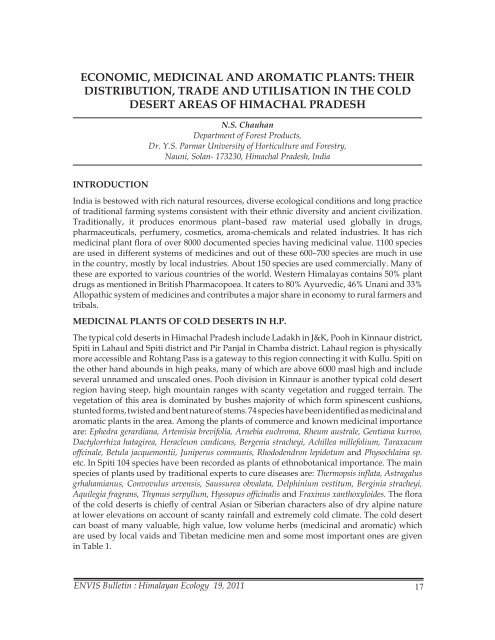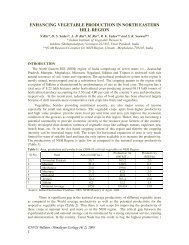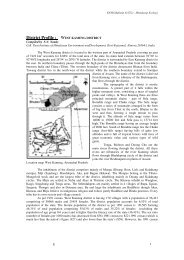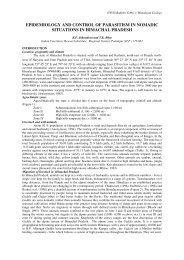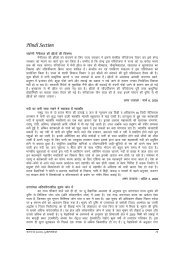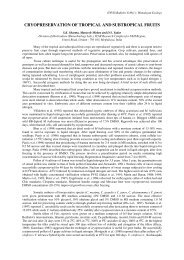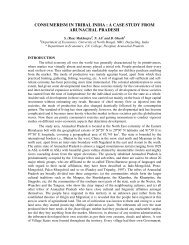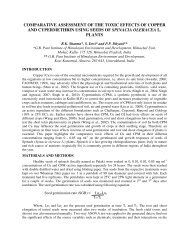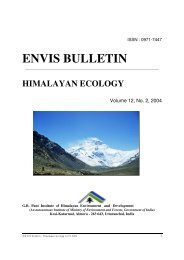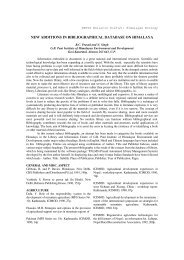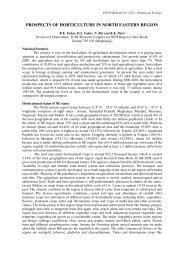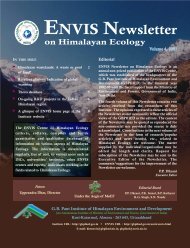Complete Bulletin (PDF) - ENVIS Centre on Himalayan Ecology
Complete Bulletin (PDF) - ENVIS Centre on Himalayan Ecology
Complete Bulletin (PDF) - ENVIS Centre on Himalayan Ecology
You also want an ePaper? Increase the reach of your titles
YUMPU automatically turns print PDFs into web optimized ePapers that Google loves.
ECONOMIC, MEDICINAL AND AROMATIC PLANTS: THEIRDISTRIBUTION, TRADE AND UTILISATION IN THE COLDDESERT AREAS OF HIMACHAL PRADESHN.S. ChauhanDepartment of Forest Products,Dr. Y.S. Parmar University of Horticulture and Forestry,Nauni, Solan- 173230, Himachal Pradesh, IndiaINTRODUCTIONIndia is bestowed with rich natural resources, diverse ecological c<strong>on</strong>diti<strong>on</strong>s and l<strong>on</strong>g practiceof traditi<strong>on</strong>al farming systems c<strong>on</strong>sistent with their ethnic diversity and ancient civilizati<strong>on</strong>.Traditi<strong>on</strong>ally, it produces enormous plant–based raw material used globally in drugs,pharmaceuticals, perfumery, cosmetics, aroma-chemicals and related industries. It has richmedicinal plant flora of over 8000 documented species having medicinal value. 1100 speciesare used in different systems of medicines and out of these 600–700 species are much in usein the country, mostly by local industries. About 150 species are used commercially. Many ofthese are exported to various countries of the world. Western Himalayas c<strong>on</strong>tains 50% plantdrugs as menti<strong>on</strong>ed in British Pharmacopoea. It caters to 80% Ayurvedic, 46% Unani and 33%Allopathic system of medicines and c<strong>on</strong>tributes a major share in ec<strong>on</strong>omy to rural farmers andtribals.MEDICINAL PLANTS OF COLD DESERTS IN H.P.The typical cold deserts in Himachal Pradesh include Ladakh in J&K, Pooh in Kinnaur district,Spiti in Lahaul and Spiti district and Pir Panjal in Chamba district. Lahaul regi<strong>on</strong> is physicallymore accessible and Rohtang Pass is a gateway to this regi<strong>on</strong> c<strong>on</strong>necting it with Kullu. Spiti <strong>on</strong>the other hand abounds in high peaks, many of which are above 6000 masl high and includeseveral unnamed and unscaled <strong>on</strong>es. Pooh divisi<strong>on</strong> in Kinnaur is another typical cold desertregi<strong>on</strong> having steep, high mountain ranges with scanty vegetati<strong>on</strong> and rugged terrain. Thevegetati<strong>on</strong> of this area is dominated by bushes majority of which form spinescent cushi<strong>on</strong>s,stunted forms, twisted and bent nature of stems. 74 species have been identified as medicinal andaromatic plants in the area. Am<strong>on</strong>g the plants of commerce and known medicinal importanceare: Ephedra gerardiana, Artemisia brevifolia, Arnebia euchroma, Rheum australe, Gentiana kurroo,Dactylorrhiza hatagirea, Heracleum candicans, Bergenia stracheyi, Achillea millefolium, Taraxacumoffcinale, Betula jacquem<strong>on</strong>tii, Juniperus communis, Rhododendr<strong>on</strong> lepidotum and Physochlaina sp.etc. In Spiti 104 species have been recorded as plants of ethnobotanical importance. The mainspecies of plants used by traditi<strong>on</strong>al experts to cure diseases are: Thermopsis inflata, Astragalusgrhahamianus, C<strong>on</strong>vovulus arvensis, Saussurea obvalata, Delphinium vestitum, Berginia stracheyi,Aquilegia fragrans, Thymus serpyllum, Hyssopus officinalis and Fraxinus xanthoxyloides. The floraof the cold deserts is chiefly of central Asian or Siberian characters also of dry alpine natureat lower elevati<strong>on</strong>s <strong>on</strong> account of scanty rainfall and extremely cold climate. The cold desertcan boast of many valuable, high value, low volume herbs (medicinal and aromatic) whichare used by local vaids and Tibetan medicine men and some most important <strong>on</strong>es are givenin Table 1.<str<strong>on</strong>g>ENVIS</str<strong>on</strong>g> <str<strong>on</strong>g>Bulletin</str<strong>on</strong>g> : <strong>Himalayan</strong> <strong>Ecology</strong> 19, 2011 17


